Physical Address
304 North Cardinal St.
Dorchester Center, MA 02124
Progress in liver transplantation in essence has been a story of the progress in developing immunosuppressant drugs. Although initial attempts at liver transplantation in Denver and Cambridge in the 1960s and 1970s using azathioprine, steroids, and antilymphocyte globulin had some success, it was not until the development of cyclosporine in 1978 that liver transplantation became a truly viable option with good chances of long-term success. From there, over the last 35 years, newer and different immunosuppressant drugs have been developed. From cyclosporine to tacrolimus, from mycophenolate to sirolimus, and to the more specific antibody-based therapies of today—the field of liver transplantation has been defined by these medications. Although advances in surgical technique, anesthesiology, and intensive care unit management have improved early outcomes, it is the progress in immunosuppression that has allowed long-term success.
Liver transplant recipients now live longer, with survival being measured in decades, and the immunosuppression strategies have improved to the point that rejection is no longer the only concern. The focus of immunosuppression management has now switched to one of limiting the complications and risks associated with long-term maintenance immunosuppression. Given the variety of diseases and complications that present in liver recipients, there is no uniform approach to immunosuppression, and strategies have to be tailored to the individual. It is unrealistic to expect a single immunosuppression strategy to be effective in all cases—one size does not fit all. The art of immunosuppression management is about adapting all of these available immunosuppression options, controlling different elements of the immune response to the allograft, in the most optimal fashion for the patient.
The alloimmune response requires numerous cells to accomplish T-cell proliferation, T-cell differentiation, B-cell activation, and alloantibody production. Donor antigens are presented to the recipient lymphocytes by antigen-presenting cells (APCs), which break up and process foreign proteins and load them onto the major histocompatibility complexes, displayed on their surface. When the major histocompatibility complex and a specific T-cell receptor complex (TCR-CD3) interact, this alloantigen recognition triggers what is referred to as “signal 1,” the first signal in what is termed the three-signal hypothesis of lymphocyte activation. The next required component of the alloimmune response, referred to as “signal 2,” is the costimulation signaling, and it occurs when the CD80 and CD86 molecule on the APC bind to the CD28 molecule on the T cell. In order for full T-cell activation to occur, both signal 1 and signal 2 must occur, and when this happens, their activation causes a cascade of subsequent signals that leads to the dephosphorylation of, and subsequent migration from the cytoplasm to the nucleus, of nuclear factor of activated T cells (NFAT). Once in the nucleus, NFAT promotes the transcription of both interleukin (IL)-2 and the IL-2 receptor (IL-2R), which helps to amplify this proliferative response. When IL-2 binds the IL-2R that is now expressed on the T-cell surface—which is referred to as “signal 3”—an intracellular cascade activates mammalian target of rapamycin (mTOR), which initiates the G0 to G1 transition of the cell cycle and leads to cell division, proliferation, and differentiation of that specific T cell; this response is known as T-cell activation, and these activated T cells will target any cells carrying that specific donor antigen ( Fig. 91-1 ).
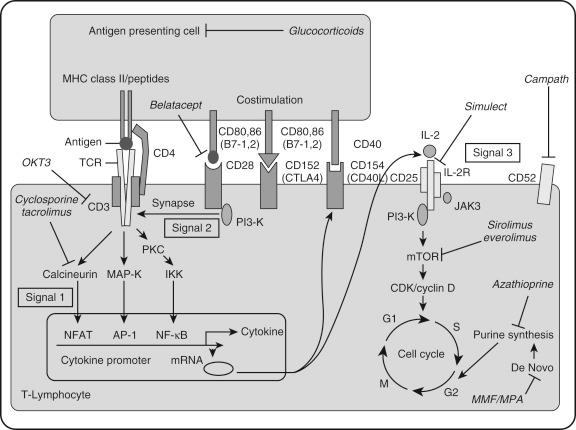
Immunosuppression is charged with preventing the alloimmune response against donor antigens. There are a large number of different immunosuppressant drugs available today, and their complexity and diversity of action can make the concept of immunosuppression appear complicated. In reality, all of these immunosuppressant drugs simply do one of three things: they either inhibit one of the three key signals, they limit the supply of nucleotides needed for cell division, or they deplete one of the necessary immune cells.
Signal 1 blockers include calcineurin inhibitors (CNIs) such as cyclosporine and tacrolimus, as well as any anti-CD3 molecules that block the T-cell receptor complex such as OKT3 and rabbit-derived antithymocyte globulin (rATG). Signal 2 blockers include belatacept, which competitively binds the costimulatory molecule CD28, preventing it from binding CD80/CD86. Signal 3 blockers include both anti-CD25 antibodies that competitively bind the IL-2R, such as basiliximab, as well as mTOR inhibitors such as sirolimus and everolimus, which prevent any further downstream signal transduction if the IL-2R becomes activated
Drugs that limit the supply of purine nucleotides needed for cell division include azathioprine and mycophenolate.
Drugs that deplete the necessary immune cells include rATG, which depletes and lyses T cells; OKT3, which also depletes T cells; and alemtuzumab, an anti-CD52 molecule that lyses B cells and T cells.
Modern immunosuppression strategies involve using these drugs in combinations to achieve the goal of preventing alloimmune response against donor antigens, while minimizing any toxicities and side effects.
Calcineurin inhibitors are the backbone of immunosuppression regimens. Calcineurin is a calcium-dependent protein phosphatase that is integral to T-cell activation. When an APC successfully binds a T-cell receptor, it leads to an increase in intracellular calcium, which activates the calcineurin, which in turn phosphorylates the transcription factor NFAT. NFAT translocates into the nucleus, where it upregulates IL-2 expression, a key step in T-cell activation and subsequent proliferation. Calcineurin inhibitors are a class of drugs that inhibit calcineurin and ultimately prevent T-cell activation and proliferation.
Cyclosporine (Neoral) was the first CNI developed. It is a lipophilic cyclic polypeptide isolated from the fungus Tolypocladium inflatum , first identified from soil samples obtained in 1969. Further studies elucidated its immunosuppressive properties in 1972, and it was successfully shown to prevent rejection in kidney transplant recipients in 1978 by the group at Cambridge and further shown to prevent rejection in liver transplant recipients by the group at Denver/Pittsburgh. Cyclosporine is responsible for the significant improvements in allograft survival and was the key to advances that facilitated the field of transplantation.
Signal 1 is the signal inhibition target.
Cyclosporine blocks Signal 1 of T-cell activation by binding to the immunophillin cyclophilin, which in turn binds to calcineurin and prevents the activation of NFAT. Inhibition of NFAT prevents transcription of IL-2, interferon (IFN)-γ, and lymphokines and stalls lymphocytes in the G0 or G1 phase of the cell cycle. This prevents T-cell proliferation and the alloimmune response.
Cyclosporine is a poorly absorbed drug, and this detail complicated the initial formulation of the medication (Sandimmune); however, a subsequent version was developed (Neoral), and it was formulated as a nonaqueous microemulsified capsule that allowed for improved absorption. Bioavailability is variable and ranges from 18% to 54%. Bile is necessary for adequate absorption of cyclosporine, and any condition that limits bile excretion, such as biliary obstruction, will reduce cyclosporine absorption. Cyclosporine is metabolized by the cytochrome P-450 3A4 system, and any substance interacting with the P-450 3A4 subunit can alter the cyclosporine serum level. Drugs that increase cyclosporine levels include macrolides such as erythromycin, azole antifungals such as fluconazole, calcium channel blockers such as verapamil, and protease inhibitors for human immunodeficiency virus and hepatitis C virus (HCV) such as indinavir and telaprevir ( Fig. 91-2 ). In addition, food such as grapefruit can also increase cyclosporine levels. Drugs that decrease cyclosporine levels include antibiotics such as rifabutin and rifampin, anticonvulsants such as carbamazepine, phenobarbital, and phenytoin, and St John’s wort. Cyclosporine has a variable half-life, with a mean of about 18 hours.
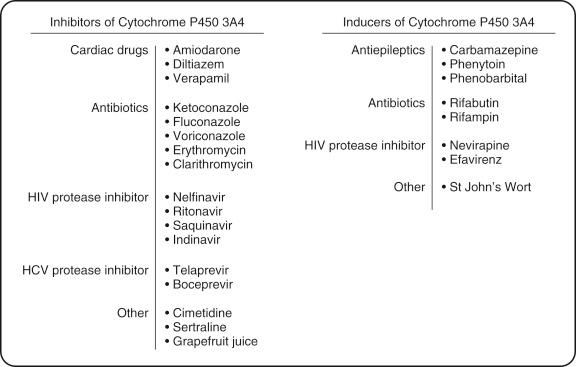
A typical starting dose of cyclosporine is 2 to 3 mg/kg by mouth twice a day. Cyclosporine dosing is then titrated using serum trough levels of 300 ng/mL initially, and a level of 150 ng/mL 6 weeks post transplant.
Cyclosporine causes both a reversible acute nephrotoxicity and an irreversible chronic nephrotoxicity. The acute form of nephrotoxicity is linked to endothelin and other vasoconstrictors that cause afferent arterial vasoconstriction, as well as an activation of the renin-angiotensin system. The endothelial dysfunction is essential in the pathogenesis of nephrotoxicity. In the chronic form of nephrotoxicity, hyaline thickening in the afferent arterioles is the hallmark, along with interstitial fibrosis and tubular atrophy and glomerulosclerosis. Upregulation of transforming growth factor (TGF)-β, which promotes fibrosis, is the key etiological factor in chronic nephrotoxicity. Nephrotoxicity is treated with a dose reduction or discontinuation of the CNI (see Renal Dysfunction section in Immunosuppression Strategies in Patients With Special Considerations).
Cyclosporine can cause headaches, tremors, confusion, agitation, dysarthria, seizures, and coma. Symptoms can often be improved with a dose reduction, and those refractory to dose reduction may require discontinuation of the CNI. Recipients particularly sensitive to neurotoxicity from cyclosporine are those with fulminant hepatic failure and severely decompensated cirrhotic patients with stage 3 to 4 encephalopathic coma due to potential blood barrier compromise. Initiation of tacrolimus should be delayed until the patient is awake (see Neurotoxicity section in Immunosuppression Strategies in Patients With Special Considerations).
Although not common, gingival hyperplasia and hirsutism elicit distress in many patients. The symptoms resolve with discontinuation of cyclosporine.
Other side effects include hypertension, hyperlipidemia, hyperkalemia, and weight gain.
Tacrolimus (FK506, Prograf) is a macrolide that was isolated from the actinomycete Streptomyces . It was first used in renal transplantation in 1989 and was approved for liver transplantation in 1994.
Signal 1 is the signal inhibition target.
Tacrolimus interferes with signal 1 of T-cell activation by binding to the immunophillin FK506-binding protein (FKBP-12), which in turn binds to calcineurin, which prevents it from activating NFAT. In a similar fashion to the mechanism of cyclosporine, inhibition of NFAT prevents transcription of IL-2, IFN-γ, and lymphokines, stalling lymphocytes in the G0 or G1 phase of the cell cycle and preventing proliferation, which leads to immunosuppression.
Tacrolimus is 100 times more potent than cyclosporine because of its higher affinity to its immunophillin compared to cyclosporine, and it also has better bioavailability of 22% optimally absorbing in fasting conditions. Tacrolimus is metabolized by the cytochrome P-450 3A4 subunit, and the medications listed earlier that alter the level of cyclosporine listed will similarly alter tacrolimus serum levels. The half-life of tacrolimus is 11.7 hours.
The typical starting dose of tacrolimus is 0.02 to 0.03 mg/kg by mouth twice a day. Tacrolimus dosing is then titrated using serum trough levels of 8 to 12 ng/mL initially, and a level of 7 ng/mL 6 weeks post transplant.
Tacrolimus causes both a reversible acute nephrotoxicity and an irreversible chronic nephrotoxicity. The acute form of nephrotoxicity is linked to endothelin and other vasoconstrictors that cause afferent arterial vasoconstriction, as well as an activation of the renin-angiotensin system. The endothelial dysfunction is essential in the pathogenesis of nephrotoxicity. In the chronic form of nephrotoxicity, hyaline thickening in the afferent arterioles is the hallmark, along with interstitial fibrosis and tubular atrophy and glomerulosclerosis. Upregulation of TGF-β, which promotes fibrosis, is the key etiological factor in chronic nephrotoxicity. CNI nephrotoxicity is common, and up to 20% of liver recipients have chronic renal failure by 5 years post transplant (see Immunosuppression Strategies in Patients With Special Considerations: Renal Dysfunction).
Tacrolimus can cause headaches, tremors, confusion, agitation, dysarthria, seizures, and coma, with headache being most common. Neurotoxicity occurs more frequently with tacrolimus compared to cyclosporine. Symptoms can often be improved with a dose reduction, and those refractory to dose reduction may require discontinuation of the tacrolimus, converting to cyclosporine or an mTOR inhibitor. Recipients particularly sensitive to neurotoxicity from tacrolimus are those with fulminant hepatic failure and severely decompensated cirrhotic patients with stage 3 to 4 encephalopathic coma. For this group the tacrolimus should be delayed until the patent is awake (see Neurotoxicity section in Immunosuppression Strategies in Patients With Special Considerations).
New-onset diabetes occurs more frequently in patients on tacrolimus compared to cyclosporine, and tacrolimus further potentiates the hyperglycemic effects of steroids.
Tacrolimus can cause hemolytic uremic syndrome (HUS), as a result of mechanical injury to the glomeruli by the drug, and HUS can occur despite therapeutic levels. It presents as anemia, thrombocytopenia, and renal failure from microthrombi deposition. HUS is treated by tacrolimus discontinuation and initiation of plasmapheresis. An alternative therapy is eculizumab, a monoclonal antibody directed against the complement component.
Hypertension is more common with tacrolimus compared to cyclosporine. Other side effects include hyperkalemia and hyperlipidemia.
Both tacrolimus and cyclosporine are metabolized by the cytochrome P-450 3A4 system, and any substance interacting with the P-450 3A4 subunit will alter tacrolimus and cyclosporine serum levels, which can lead to rejection or calcineurin inhibitor (CNI) toxicities if the dosages of CNI are not adjusted accordingly.
Bile is necessary for adequate absorption of cyclosporine, and any condition that limits bile excretion, such as biliary obstruction, will reduce cyclosporine absorption. Tacrolimus absorption is unaffected by bile and is not impacted by biliary obstruction
Tacrolimus and cyclosporine can cause hemolytic uremic syndrome (HUS), and this pathologic condition is commonly missed because the symptoms of anemia, thrombocytopenia, and renal failure are considered typical posttransplant symptoms. HUS should always be considered in any patient receiving CNI with an unexplained renal dysfunction.
The class of immunosuppressants known as mTOR inhibitors are substances that inhibit the complex and multifaceted mTOR pathway. As our understanding of the upstream and downstream elements of the mTOR pathway improve, so does our understanding of the side effects and benefits associated with mTOR inhibitors ( Fig. 91-3 ).
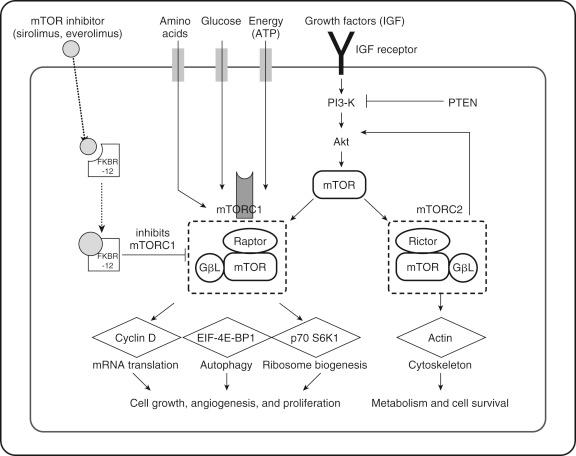
mTOR (also known as FRAP1—FK506-binding protein 12-rapamycin associated protein) is an evolutionarily conserved serine/threonine protein kinase encoded by the FRAP 1 gene, and it acts as a sensor of cellular homeostasis, integrating the extracellular and intracellular environments. mTOR coordinates cellular growth, proliferation, and nutrition by sensing cellular stress based on oxygen, energy, mitogenic growth factors, hormones, and cellular nutrient levels.
mTOR sits at the nexus of several separate downstream pathways. The one most relevant to its immunosuppressant function is its regulation of the p70S6 kinase gene, which controls translation of cell cycle–regulating proteins such as cyclin-E and cyclin-A dependent kinase; these kinases control the cell cycle transition from G1 to S phase. By inhibiting mTOR, we can prevent cell cycle transition and limit cellular proliferation, particularly the proliferation and activation of lymphocytes.
Sirolimus (rapamycin, Rapamune) is a macrolide derived from the actinomycete Streptomyces hygroscopicus . It was initially developed as an antifungal agent, but study along this line was halted when it was also shown to have immunosuppressive properties.
Signal 3 is the signal inhibition target.
Sirolimus binds to the same immunophillin FKBP-12 (see Fig. 91-3 ) as tacrolimus; however, this complex does not interact with calcineurin but is instead a highly specific inhibitor of mTOR. By inhibiting mTOR, sirolimus blocks IL-2 and IL-15 induction of T- and B-cell proliferation through inhibition of the p70S6 kinase and prevents progression of the cell cycle from the G1 to S phase. Unlike a CNI, which blocks signal 1 of T-cell activation, sirolimus blocks signal 3 of T-cell activation. In addition to inhibiting T-cell proliferation, sirolimus inhibits both B-cell immunoglobulin synthesis and antibody-dependent cellular cytotoxicity, natural killer cells, and lymphocyte-activated killer cells.
Sirolimus is rapidly absorbed with a bioavailability of 14%, which can be decreased when taken with a high-fat meal. Sirolimus is metabolized by the cytochrome P-450 3A4 system and is affected by the same drugs that affect cyclosporine. Coadministration of sirolimus and cyclosporine increases levels, so sirolimus is typically given 4 hours after cyclosporine to avoid this occurrence. Sirolimus has a half-life of 63 hours; however, because it has a shorter effective half-life, the drug reaches steady state in 7 days.
Sirolimus is not approved for liver transplant recipients. When using the drug off label, sirolimus should be given as a starting dose of 2 mg daily without a loading dose. The dose is titrated to obtain a level between 4 and 10 ng/mL.
Hyperlipidemia is the most common reported side effect ( Fig. 91-4 ) from the registration trials of sirolimus, with twice as many patients requiring lipid-lowering agents compared to CNI. Despite the increased lipids and triglycerides with sirolimus, animal models have shown that sirolimus reduces atherosclerosis. Additionally, a large study of liver transplant recipients receiving de novo sirolimus showed no impact on cardiovascular events in the sirolimus cohort despite having higher cholesterol and triglyceride levels and a significantly higher Framingham Risk Score. Hyperlipidemia can be managed with statin therapy, and hypertriglyceridemia is treated with fish oil capsules.
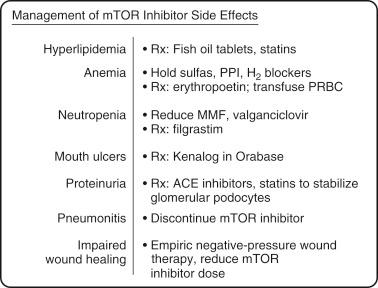
Cytopenias are the second most common side effect from sirolimus, due to the impact of sirolimus on the cell cycle and cell proliferation. In most cases, neutropenia from an mTOR inhibitor is not clinically significant because there is no increase in the incidence of bacterial infection with mTOR inhibitor use. Anemia from mTOR inhibitors typically occurs in the initial posttransplant period and resolves over time. Both neutropenia and thrombocytopenia can be improved by limiting other medications that also cause cytopenias, such as sulfas, histamine 2 (H 2 ) blockers, and proton pump inhibitors.
In addition to cell cycle regulation, mTOR affects several processes that impact fibrogenesis, and mTOR inhibition with sirolimus causes (1) decreased type 1 collagen messenger RNA synthesis; (2) decreased fibroblast proliferation from inhibited expression of profibrotic growth factors MGP-1, platelet-derived growth factor, and TGF-β; and (3) disrupted fibroblast attachment by impacting the α-1β-3 integrin pathway. This impacts surgical incision healing, and there are reports of increased risk for hernias, especially when sirolimus is combined with an antiproliferative such as mycophenolate. When elective surgery is planned, sirolimus should be temporarily converted to a CNI 2 weeks before surgery until approximately 4 weeks after surgery to allow healing.
Although mTOR inhibitors do not cause any renal tubular dysfunction, they are associated with a higher incidence of proteinuria. The mechanism for this proteinuria, as well as the long-term implications of it, are unknown. Possible treatment strategies to limit the proteinuria are statin therapy and ACE inhibitors.
Pneumonitis is an important, but rare, complication associated with higher therapeutic levels that is now rarely seen with current dosing strategies. It presents as fever, dyspnea, and cough, along with a diffuse ground-glass infiltrate on chest x-ray examination, that can lead to hypoxia and respiratory failure. There is no therapy for this pneumonitis beyond discontinuation of the mTOR inhibitor, and although the condition is reversible, it can be fatal if it is not recognized and addressed.
Mouth ulcers are a common side effect of sirolimus use, affecting up to 25% of patients. Often mistaken for herpetic ulcers, these painful ulcers are easily treated with Kenalog in Orabase applied directly to the oral ulcer twice daily. For severe ulcers the sirolimus dose should be reduced, and it is only the very rare patient that does not respond to therapy and requires discontinuation of the sirolimus.
A 2003 Food and Drug Administration (FDA) black box warning regarding de novo sirolimus in liver transplant warns of an increased incidence of hepatic artery thrombosis (HAT). This warning was based on two registration trials that showed a significant increase in HAT with de novo sirolimus ; however, it remains controversial, and there are many questions regarding those study designs. A preponderance of evidence since 2003 has shown either a reduction in HAT or no difference in HAT with de novo sirolimus, and none of the more than 20 reports since 2003 corroborate the black box warning, with most showing reduced HAT with sirolimus use. There might still be an association of HAT with administration of a large loading dose of sirolimus (as was used in the registration trials), so loading doses of sirolimus should be avoided.
Everolimus (Zortress, Certican) is a macrolide derived from the actinomycete Streptomyces hygroscopicus . It is a derivative of sirolimus and has a very similar chemical structure. Everolimus is from the class of immunosuppressants termed mTOR inhibitors
Signal 3 is the signal inhibition target.
Everolimus has the same mechanism of action as sirolimus described earlier. It binds to the immunophillin FKBP-12, and this complex is a highly specific inhibitor of mTOR, which ultimately blocks IL-2 and IL-15 induction of T- and B-cell proliferation through inhibition of the p70S6 kinase. This prevents the progression of the cell cycle from the G1 to S phase, thereby blocking signal 3 of T-cell activation.
Everolimus has a bioavailability of 18%, which is slighter higher than that of sirolimus. It is metabolized by the cytochrome P-450 3A4 system, so the drugs that impact sirolimus and cyclosporine will also affect everolimus concentrations. Everolimus has a shorter half-life of 30 hours compared to sirolimus.
Everolimus should be given as a starting dose of 1 mg twice a day without a loading dose. The dose is titrated to obtain a level between 3 to 8 ng/mL.
Hyperlipidemia and hypertriglyceridemia are the most common side effects associated with everolimus, like other mTOR inhibitors. Hyperlipidemia is managed by statin therapy, and hypertriglyceridemia is treated with fish oil tablets.
Neutropenia, anemia, and thrombocytopenia are common complications from everolimus, and they are dose related. As with other mTOR inhibitors, both neutropenia and thrombocytopenia can be improved by limiting other medications that also cause cytopenias, such as sulfas, H 2 blockers and proton pump inhibitors.
By inhibiting mTOR, everolimus inhibits the fibrogenesis processes that mTOR controls, including type 1 collagen messenger RNA and fibroblast proliferation. This leads to impaired wound healing and results in an increased risk for hernias and wound issues. When elective surgery is planned, everolimus should be temporarily converted to a CNI 2 weeks before surgery until approximately 4 weeks after surgery to allow healing.
Although mTOR inhibitors do not cause any renal tubular dysfunction, they are associated with a higher incidence of proteinuria. The mechanism for this proteinuria, as well as the long-term implications of it, are unknown. There is debate as to whether the proteinuria seen with everolimus is similar to that of the other mTOR inhibitor, sirolimus.
Initial concerns of hepatic artery thrombosis (HAT) from mammalian target of rapamycin (mTOR) inhibitors in de novo liver transplant recipients have not been borne out in any of the many subsequent studies. If mTOR inhibitors are considered useful management for a particular liver recipient, a concern of possible HAT should not prevent a clinician from using the medication.
Before any elective surgery, mTOR inhibitors should be held for 2 weeks before and 4 weeks following the surgery to allow wound healing.
Hypertriglyceridemia is a common side effect from mTOR inhibitors; however, it is not associated to an increased risk for cardiovascular disease due to the cardioprotective effects of mTOR inhibitors.
Mycophenolate mofetil (MMF) (CellCept) and the enteric-coated mycophenolate sodium (Myfortic) are both esters that are hydrolyzed to the active form mycophenolic acid (MPA). It was first approved in 1995 in renal transplantation, and researchers quickly adapted it to liver transplantation.
Signal 3 is the signal inhibition target.
MPA blocks de novo purine synthesis ( Fig. 91-5 ) by inhibiting type 2 inosine monophosphate dehydrogenase (IMPDH), which is the rate-limiting enzyme in the production of guanosine monophosphate. This decreases DNA synthesis and limits cellular replication, unless the cell has the ability to produce guanosine monophosphate through the purine salvage pathway. Both B and T lymphocytes lack the enzyme hypoxanthine-guanine phosphoribosyltransferase, which is a key enzyme in the purine salvage pathway, and thus MMF specifically inhibits lymphocyte replication, because the cell cycle stays in the S phase. This impacts both cellular immunity and antibody production. In addition to its impact on lymphocyte replication, MPA indirectly impacts the immune system by reducing leukocyte adhesion to endothelial cells and decreasing the recruitment of lymphocytes and monocytes into inflammatory tissue.
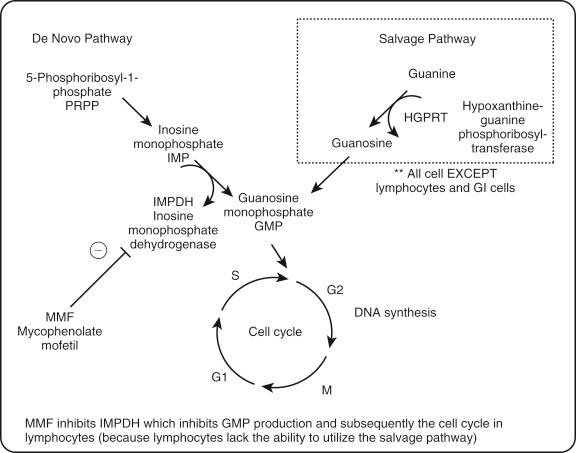
MMF is rapidly hydrolyzed in the stomach into MPA and absorbed with a bioavailability of 94%. The absorption is limited by food, so MMF should be given before meals. MMF has a half-life of 17 hours, and it is converted to an inactive form, mycophenolate glucuronide, in the liver, where it undergoes enterohepatic recycling before it is ultimately excreted in the urine. In contrast, enteric-coated mycophenolate sodium is hydrolyzed in the small intestine from a pH-dependent process. The bioavailability of mycophenolate sodium of 72% is lower than that of MMF, and it has a half-life of 16 hours.
MMF is dosed 1 to 3 g by mouth, divided, usually twice a day. Mycophenolate sodium is dosed 720 to 2160 mg by mouth, divided.
Gastrointestinal disturbances, particularly nausea, diarrhea, and abdominal pain, are the most common side effect of MMF use. These are dose related, and treatment includes either giving the same total dose divided at an increased frequency (three times a day or four times a day) or halving the dose and keeping the same dose frequency. If symptoms persist, the patient can be converted to the enteric-coated preparation mycophenolate sodium.
Neutropenia is a common side effect of MMF use and is most common in the first 6 months post transplant. Severe neutropenia (absolute neutrophil count < 500) develops in 3.6% of liver transplant recipients. Treatment options include a dose reduction and discontinuation of other medications that can also cause neutropenia. Treatment for severe neutropenia also includes filgrastim (Neupogen) 300 mcg subcutaneously.
Use of MMF during pregnancy is associated with a risk of first-trimester pregnancy loss and congenital malformations. It is recommended by the FDA that women of childbearing potential taking MMF receive contraceptive counseling and use effective contraception.
Azathioprine (Imuran) is one of the oldest immunosuppressants in transplantation, having been used for more than 50 years. It is a prodrug of 6-mercaptopurine that inhibits IMPDH and prevents purine synthesis. It is neither neurotoxic nor nephrotoxic and is a useful immunosuppressant for patients presenting with those complications.
Signal 3 is the signal inhibition target.
Become a Clinical Tree membership for Full access and enjoy Unlimited articles
If you are a member. Log in here